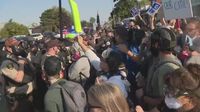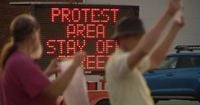On Friday morning, the usually quiet suburb of Broadview, Illinois, found itself thrust into the national spotlight as armored vehicles, masked federal agents, and snipers took up positions outside the local Immigration and Customs Enforcement (ICE) facility. The scene, captured on live television and widely circulated on social media, was described by one observer as “insane” and “not America anymore.” The images—protesters being dragged away, tear gas clouding the air, and Homeland Security Secretary Kristi Noem herself atop the facility’s roof with a film crew—have ignited fierce debate about the treatment of protesters, federal immigration policy, and the boundaries of civil liberties in the United States.
The Broadview ICE facility has become a flashpoint in recent weeks, following its prominent role in the Trump administration’s Operation Midway Blitz. The operation’s legacy, as reported by The New Republic, has drawn a steady stream of demonstrators to the facility’s gates. Many Illinoisans, including local politicians and advocacy groups, have accused federal agents of using excessive force to suppress peaceful protest. The situation escalated dramatically on October 3, 2025, when more than a dozen protesters were arrested amid violent skirmishes with heavily militarized law enforcement.
Among those arrested was Kat Abughazaleh, a Democratic U.S. House candidate for Illinois, who described her experience to The New Republic after being thrown to the ground by an ICE agent. “They’re committing crimes against humanity there,” she said, echoing the sentiments of many demonstrators who have reported being tackled, dragged away, and menaced by masked agents clad in tactical gear. Social media footage from the day showed an imposing federal presence—snipers on armored vehicles and officers from multiple agencies patrolling the perimeter. The morning’s events quickly became the subject of national attention, with the hashtag #BroadviewICE trending as videos of the crackdown circulated online.
Homeland Security Secretary Kristi Noem’s presence at the facility added fuel to the fire. Video captured by an ABC7 Chicago helicopter showed Noem on the roof of the ICE building, surrounded by cameras and a production crew. Critics, including Illinois Governor JB Pritzker, accused her of staging a political photo opportunity amid the chaos. Noem’s penchant for media stunts has earned her nicknames like “Cosplay Kristi” and “ICE Barbie” among detractors. The day’s theatrics didn’t end there: Border Patrol commander-at-large Gregory Bovino, also present with Noem, was filmed by journalist Taha Syed shouting at a protester before physically joining a scuffle on the ground.
Governor Pritzker was quick to condemn the federal response. In a pointed thread on X (formerly Twitter), he wrote, “Federal agents reporting to Secretary Noem have spent weeks snatching up families, scaring law-abiding residents, violating due process rights, and even detaining U.S. citizens.” Pritzker demanded public accountability, insisting, “Secretary Noem should no longer be able to step foot inside the State of Illinois without any form of public accountability.” He underscored that “Illinois is not a photo opportunity or warzone,” emphasizing the state’s sovereignty and the rights of its residents.
Even as tensions flared, local and state law enforcement agencies were keen to clarify their role. According to CBS News, police maintained that they were “not assisting ICE with any detention operations.” Nonetheless, their presence—alongside federal agents—drew criticism from activists who questioned the true extent of their involvement.
In response to the escalating confrontations, Illinois and Cook County officials moved to implement new safety measures outside the Broadview facility. A temporary unified command was established, bringing together the Illinois State Police, Cook County Sheriff’s Office, Cook County Department of Emergency Management and Regional Security, and the Illinois Emergency Management Agency. The goal, as articulated by the Illinois State Police, was to “protect the health and safety of all individuals, including nearby Broadview residents and businesses, while enabling the peaceful expression of First Amendment rights.”
Central to the new approach were designated protest zones and the installation of concrete barriers—meant to form a restricted area between demonstrators and the ICE facility while maintaining access for vehicles. The barriers replaced a previously installed wire fence and gate, which had drawn complaints from protesters and local officials alike. The hope, officials said, was that a defined separation would help mitigate potential conflicts and allow for peaceful protest.
Not everyone is convinced these measures will work. Attorney Robert Held, associated with the Chicago Council of Lawyers and a frequent participant in the protests, has been vocal in his criticism. Previously detained by ICE agents himself, Held questioned the need for a so-called “First Amendment zone,” arguing that the creation of such areas could undermine the very rights they’re supposed to protect. “It’s ICE that has actually been violating the law, by firing less-than-lethal weapons at peaceful demonstrators,” Held asserted, reflecting a broader skepticism among activists about the motives behind the new restrictions.
Held recounted his own arrest during a protest, describing the actions of federal agents as excessive and more theatrical than legally necessary. “Before demanding the crowd to clear the street, an ICE chief opened a gate not for legal enforcement but as a form of ‘political theater,’” he said. For Held and his colleagues, the introduction of concrete barriers and protest zones feels like a cosmetic fix—one that fails to address deeper concerns about the use of force and the respect for civil liberties.
Despite assurances from the Illinois State Police that uniformed officers would guide the public to designated protest areas and keep access open for legal representatives and medical personnel, concerns remain about the enforcement of these new boundaries. The agencies involved have stressed that their operations would not interfere with federal immigration enforcement and would comply with state and federal laws. Yet, the effectiveness of these measures in preventing future confrontations is still an open question.
The underlying tensions at Broadview reflect a national debate about the role of federal immigration enforcement and the rights of protesters. For some, the heavy-handed response to demonstrations is a necessary measure to maintain order and protect public safety. For others, it is a troubling sign of eroding civil liberties and unchecked federal power. As Illinois and Cook County officials continue to refine their approach, the eyes of the nation remain fixed on Broadview—watching to see whether these new measures will bring peace, or simply paper over deeper conflicts.
For now, Broadview stands as a symbol of the ongoing struggle between security and freedom, and the difficult choices faced by communities caught in the crossfire of national policy and local activism.


